
Panoramic view, intersection Main Street and Brundage, Sheridan, Wyoming, 1909. Photo by F. J. Bardholtz
For Close up click here
Directly across the street at 50 N. Main is the Bank of Commerce which also housed the Masonic Temple.
Across the street to the right is the Sheridan
National Bank. Further down the street is the town hall with the cupola.
On the bottom floor was the fire station and the upper floor housed the
police department and court room. Behind the Town Hall was located a
corrigated iron jail, notorious for its ease of escape. The drugstore at the right in the photo
is now the site of the Kendrick Building constructed by John B. Kendrick, governor and
U. S. senator. In 1914 the Sheridan National Bank moved into the Kendrick Building. Note absence of trolley tracks. In close up view, note that
cross walks are set with paving stones. The next view, taken several years
later is taken from across the street. Trolley has been added, street is still unpaved.
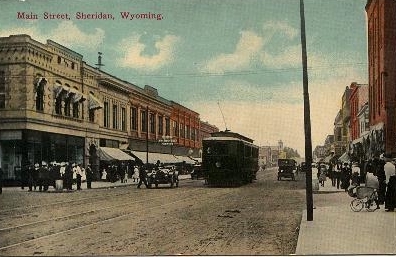
Sheridan, Main Street, approx. 1912
The building on the corner is the Diefenderfer and Dinwiddie Hardware Store at
55-59 N. Main. Further down the street at 35 N. Main is the Stevens Fryberger Building
housing the "New York Store."
Compare with view of 1918 parade in Sheridan (note trolley tracks, removed approximately 1925). Sheridan was layed out in 1882
by John D. Loucks who drew the plat on the back of a sheet of wrapping paper.
The City experienced comparatively rapid growth. By 1900 it had a population of
over 1500 and by 1910 a population of approximately 12,000.
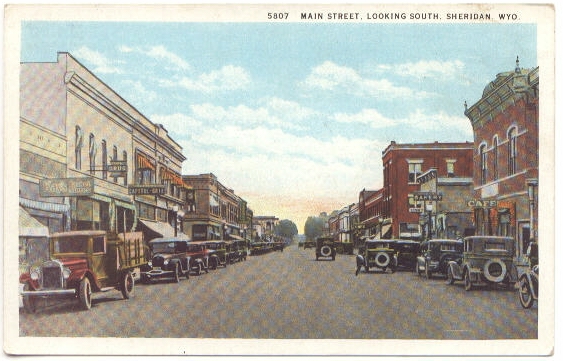
Sheridan c. 1930, looking south to intersection with Brundage.
Compare with photos above. Trolly tracks have now
been removed. The drug store in the panoramic photo is gone and has been replaced
with the Kendrick Building. The wooden building on the right, seen in the
panaramic photo still exists.
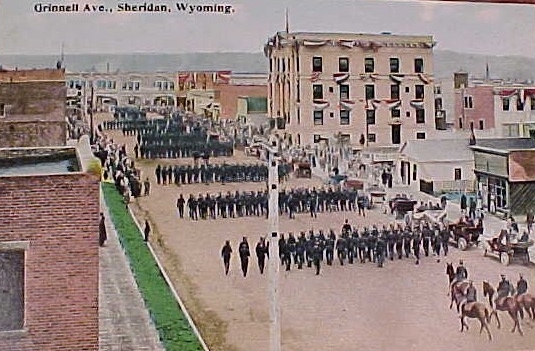
Grinnell Ave., Sheridan, looking west to intersection with Main.
The brick building on
Main with the bunting is the Meyer-Barr Building constructed in 1902. The bottom floor
has housed at different times a restaurant, a saloon, a music company and a
book, stationery store and gallery. Upstairs there have been an Eagles aerie,
a Knight of Columbus and and a business school. C. H. Grinnell was
with J. R. Phelan and George T. Beck a founder in 1893 of the Sheridan
Fuel Co., the first commercial mining company in the Sheridan area. Beck was
a partner with Wm. F. Cody in the founding of Cody, Wyo. Beck was also
the Democratic candidate for governor in 1902. Grinnell, on the other hand was in
his electorial efforts more successful in the same year, being elected city
water commissioner. According to a city directory
published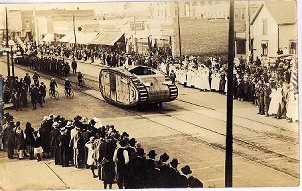 by Dinsmore & Wilson in 1894,
the City had four churches; three banks; two newspapers, The
Sheridan Post , a "seven column, eight pages Republican newspaper" and The Sheridan Enterprise, "a seven
column, four paged Democratic weekly" as well as two brick yards, a soda water
manufactory and bottling works and a two-story brick city hall. After waxing eloquently about the improvement
in the City, twice extolling Sheridan as the "Denver of the northwest", the
Editor could hardly restrain himself: by Dinsmore & Wilson in 1894,
the City had four churches; three banks; two newspapers, The
Sheridan Post , a "seven column, eight pages Republican newspaper" and The Sheridan Enterprise, "a seven
column, four paged Democratic weekly" as well as two brick yards, a soda water
manufactory and bottling works and a two-story brick city hall. After waxing eloquently about the improvement
in the City, twice extolling Sheridan as the "Denver of the northwest", the
Editor could hardly restrain himself:
"The climate is the most salubriuos [sic] and charming in the world, being specially kindly to persons affected
with pulmonary troubles. Dry pure air, not a germ of malaria, or other common
deseases [sic], a confirmed invalid is known. In summer a refreshing breeze is usually gently blowing, invigorating
everything and causing those happy, energetic people who form Sheridan's population, while in winter the
friendly 'chinook' wind mitigates the cold, killing winters of the Dakotas."
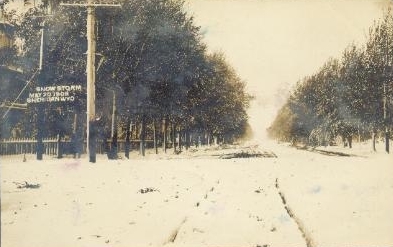
Snow storn of May 20, 1908
As can be seen from the photo and the discussion of the
great die-off with regard to cattle, the
friendly chinooks do not always mitigate the cold.
Sheridan Photos continued on next page.
|